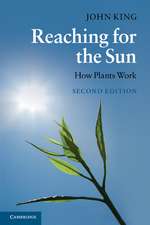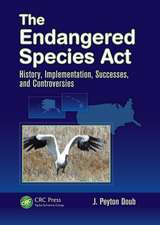Beta maritima: The Origin of Beets
Autor Enrico Biancardi, Leonard W. Panella, Robert T. Lewellenen Limba Engleză Paperback – 3 mar 2014
Dr. Enrico Biancardi graduated from Bologna University. From 1977 until 2009, he was involved in sugar beet breeding activity by the Istituto Sperimentale per le Colture Industriali (ISCI) formerly Stazione Sperimentale di Bieticoltura (Rovigo, Italy), where he released rhizomania and cercospora resistant germplasm and collected seeds of Mediterranean sea beet populations as a genetic resource for breeding and ex situ conservation. Retired since 2009, he still collaborates with several working breeders, in particular, at the USDA Agricultural Research Stations, at the Chinese Academy of Agricultural Science (CAAS), and at the Athens University (AUA). He has edited books, books chapters and authored more than 150 papers.
Dr. Lee Panella is a plant breeder and geneticist with the USDA-ARS at Fort Collins, Colorado. He earned his B.S. in Crop and Soil Science from Michigan State University, an M.S. in Plant Breeding from Texas A&M University, and a Ph.D. in genetics from the University of California at Davis. His research focus is developing disease resistant germplasm using sugar beet wild relatives. He is chairman of the USDA-ARS Sugar Beet Crop Germplasm Committee and has collected and worked extensively with sea beet.
Dr. Robert T. Lewellen was raised on a ranch in Eastern Oregon and obtained a B.S. in Crop Science from Oregon State University followed by a Ph.D. from Montana State University in Genetics. From 1966 to 2008 he was a research geneticist for the USDA-ARS at Salinas, California, where he studied the genetics of sugar beet and as a plant breeder, often used sea beet as a genetic source to produce many pest and disease resistant sugar beet germplasm and parental lines, while authoring more than 100 publications.
Preț: 1108.36 lei
Preț vechi: 1351.65 lei
-18% Nou
Puncte Express: 1663
Preț estimativ în valută:
212.11€ • 219.12$ • 176.53£
212.11€ • 219.12$ • 176.53£
Carte tipărită la comandă
Livrare economică 26 martie-09 aprilie
Preluare comenzi: 021 569.72.76
Specificații
ISBN-13: 9781489999610
ISBN-10: 1489999612
Pagini: 312
Ilustrații: XVIII, 294 p.
Dimensiuni: 155 x 235 x 16 mm
Greutate: 0.43 kg
Ediția:2012
Editura: Springer
Colecția Springer
Locul publicării:New York, NY, United States
ISBN-10: 1489999612
Pagini: 312
Ilustrații: XVIII, 294 p.
Dimensiuni: 155 x 235 x 16 mm
Greutate: 0.43 kg
Ediția:2012
Editura: Springer
Colecția Springer
Locul publicării:New York, NY, United States
Public țintă
ResearchCuprins
Foreword.- Preface.- Acknowledgments.- History and current importance.- Range of distribution.- Morphology, physiology, and ecology.- Taxonomy.- Uses.- Source of useful traits.- Cultivated offspring.- The Future.- Appendix.
Recenzii
From the reviews:
“The book is divided into eight chapters with multiple subheadings, each highlighting different aspects of B. maritima. In general, the book is well illustrated with many figures printed in colour. … it is a valuable resource for scientists involved in Beta germplasm conservation and taxonomy, as well as breeders interested in sea beet and beet history in general.” (Thomas Schmidt, Annals of Botany, Vol. 113 (7), May, 2014)
“To the best of my knowledge, this book is the first devoted entirely to sea beet (Beta maritima L.), the wild ancestor of all cultivated beets. … The book is recommended because currently there is much interest in wild beets as a source of new genetic variability for pests and diseases resistance. … the book will serve as a valued reference for students, researchers, scientists, molecular biologists, and breeders.” (Piergiorgio Stevanato, Sugar Tech, Vol. 15 (3), July-September, 2013)
“The book is divided into eight chapters with multiple subheadings, each highlighting different aspects of B. maritima. In general, the book is well illustrated with many figures printed in colour. … it is a valuable resource for scientists involved in Beta germplasm conservation and taxonomy, as well as breeders interested in sea beet and beet history in general.” (Thomas Schmidt, Annals of Botany, Vol. 113 (7), May, 2014)
“To the best of my knowledge, this book is the first devoted entirely to sea beet (Beta maritima L.), the wild ancestor of all cultivated beets. … The book is recommended because currently there is much interest in wild beets as a source of new genetic variability for pests and diseases resistance. … the book will serve as a valued reference for students, researchers, scientists, molecular biologists, and breeders.” (Piergiorgio Stevanato, Sugar Tech, Vol. 15 (3), July-September, 2013)
Textul de pe ultima copertă
Along the undisturbed shores, especially of the Mediterranean Sea and the European North Atlantic Ocean, is a quite widespread plant called Beta maritima by botanists, or more commonly sea beet. Nothing, for the inexperienced observer's eye, distinguishes it from surrounding wild vegetation. Despite its inconspicuous and nearly invisible flowers, the plant has had and will have invaluable economic and scientific importance. Indeed, according to Linnè, it is considered "the progenitor of the beet crops possibly born from Beta maritima in some foreign country". Recent molecular research confirmed this lineage. Selection applied after domestication has created many cultivated types with different destinations. The wild plant always has been harvested and used both for food and as a medicinal herb. Sea beet crosses easily with the cultivated types. This facilitates the transmission of genetic traits lost during domestication, which selection processes aimed only at features immediately useful to farmers and consumers may have depleted. Indeed, as with several crop wild relatives, Beta maritima has been successfully used to improve cultivated beet’s genetic resistances against many diseases and pests. In fact, sugar beet cultivation currently would be impossible in many countries without the recovery of traits preserved in the wild germplasm.
Dr. Enrico Biancardi graduated from Bologna University. From 1977 until 2009, he was involved in sugar beet breeding activity by the Istituto Sperimentale per le Colture Industriali (ISCI) formerly Stazione Sperimentale di Bieticoltura (Rovigo, Italy), where he released rhizomania and cercospora resistant germplasm and collected seeds of Mediterranean sea beet populations as a genetic resource for breeding and ex situ conservation. Retired since 2009, he still collaborates with several working breeders, in particular, at the USDA Agricultural Research Stations, at the Chinese Academy of Agricultural Science (CAAS), and at the Athens University (AUA). He has edited books, books chapters and authored more than 150 papers.
Dr. Lee Panella is a plant breeder and geneticist with the USDA-ARS at Fort Collins, Colorado. He earned his B.S. in Crop and Soil Science from Michigan State University, an M.S. in Plant Breeding from Texas A&M University, and a Ph.D. in genetics from the University of California at Davis. His research focus is developing disease resistant germplasm using sugar beet wild relatives. He is chairman of the USDA-ARS Sugar Beet Crop Germplasm Committee and has collected and worked extensively with sea beet.
Dr. Robert T. Lewellen was raised on a ranch in Eastern Oregon and obtained a B.S. in Crop Science from Oregon State University followed by a Ph.D. from Montana State University in Genetics. From 1966 to 2008 he was a research geneticist for the USDA-ARS at Salinas, California, where he studied the genetics of sugar beet and as a plant breeder, often used sea beet as a genetic source to produce many pest and disease resistant sugar beet germplasm and parental lines, while authoring more than 100 publications.
Dr. Enrico Biancardi graduated from Bologna University. From 1977 until 2009, he was involved in sugar beet breeding activity by the Istituto Sperimentale per le Colture Industriali (ISCI) formerly Stazione Sperimentale di Bieticoltura (Rovigo, Italy), where he released rhizomania and cercospora resistant germplasm and collected seeds of Mediterranean sea beet populations as a genetic resource for breeding and ex situ conservation. Retired since 2009, he still collaborates with several working breeders, in particular, at the USDA Agricultural Research Stations, at the Chinese Academy of Agricultural Science (CAAS), and at the Athens University (AUA). He has edited books, books chapters and authored more than 150 papers.
Dr. Lee Panella is a plant breeder and geneticist with the USDA-ARS at Fort Collins, Colorado. He earned his B.S. in Crop and Soil Science from Michigan State University, an M.S. in Plant Breeding from Texas A&M University, and a Ph.D. in genetics from the University of California at Davis. His research focus is developing disease resistant germplasm using sugar beet wild relatives. He is chairman of the USDA-ARS Sugar Beet Crop Germplasm Committee and has collected and worked extensively with sea beet.
Dr. Robert T. Lewellen was raised on a ranch in Eastern Oregon and obtained a B.S. in Crop Science from Oregon State University followed by a Ph.D. from Montana State University in Genetics. From 1966 to 2008 he was a research geneticist for the USDA-ARS at Salinas, California, where he studied the genetics of sugar beet and as a plant breeder, often used sea beet as a genetic source to produce many pest and disease resistant sugar beet germplasm and parental lines, while authoring more than 100 publications.
Caracteristici
Narrative experiences of researchers that have investigated the sea beet populations around the world and worked with the wild plant One-of-a-kind text entirely devoted to sea beet Illustrated with both detailed line drawings and color photos Includes supplementary material: sn.pub/extras








